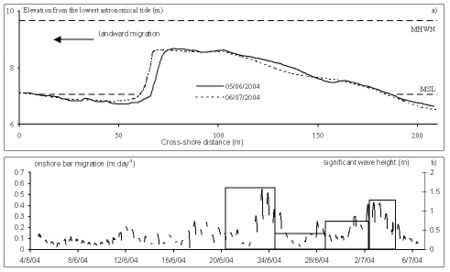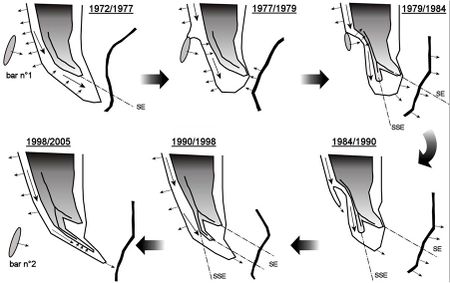French case studies: Dynamic of swash bar and hook spit formation in megatidal environment, Regneville Inlet (Normandy, France)
Tidal inlets have received a lot of attention in coastal and estuarine science and engineering because of their commercial (navigability of channels, sedimentation problems), recreational and ecological importance (METHA, 1996). These very dynamic systems have a large spatial impact on adjacent shoreline changes (LEVOY, 1994; ROBIN & LEVOY, 2007).
Contents
Introduction
Usually, isolated swash bars occur in ebb-tidal deltas (HAYES, 1975). Swash bars are built by wave-induced accumulations of sand in the distal portions of ebb deltas and move onshore. Bores produced by wave breaking across the terminal lobe combine with tidal current asymmetry thus enhancing the flood tidal currents which produce landward sand transport (OERTEL, 1972). Generally in such mixed-energy (wave-tidal) settings, the development of the large complex bars results from the landward migration and coalescence of swash bars. These bars migrate and weld to the shoreline (FITZGERALD, 1984, 1988). This attachment of bar complexes to the inlet shoreline creates a large accretion zone.
Most of the studies on ebb delta swash bars and hook spit concern only microtidal and mesotidal settings. Knowledge on morphology and dynamics of bars and spit in very large tide-range settings (spring tidal ranges > 8 m) is lacking.
The first part of this paper describes the morphology of bars located on an ebb delta of an megatidal inlet (Regnéville Inlet, Normandy, Figure 1). The second part deals with the results of a field campaign with variable hydrodynamic conditions that included 2 storm events with wave heights up to 1.2 m during one month period of time. The purpose of this experiment was to understand the processes explaining bar behaviour: e.g. bar movement in a large tide-range environment. The third part investigate the relationship between swash bar and hook spit formation.
STUDY AREA
The west Cotentin coast is a low-lying linear sandy coast bounding the Channel Islands embayment (Figure 1). This coast is cut by eight small inlets locally called “havres”. The study site concerns the largest of these havres, Regnéville Inlet. This area is characterized in the north by a complex spit, la Pointe d’Agon. This spit migrates to the south and its distal end exhibits various spit recurves. The ebb delta is large, extending more than 4 km offshore. Its northern part exhibits numerous swash bars but these are absent in its southern part (Figure 2).
The west coast of Cotentin is a fine example of a megatidal environment (LEVOY et al., 2000). The offshore area is characterized by very complex hydrodynamic conditions. The tidal wave propagating eastward from the Atlantic Ocean is reflected by the Cotentin Peninsula, generating a standing tidal wave especially within the Mont-St.-Michel Bay (Figure 1) where the maximum spring tidal range reaches 15 m, among the highest in the world. In Regnéville Inlet, the tidal range attains 11 m at mean spring tides and 14 m during exceptional spring tides. These conditions produce a mean tidal prism of 15.106 m3 per tidal cycle (mean spring tidal prism of 46.106 m3 per tidal cycle). The average fresh water discharge represents only 0.2 % of the mean spring tidal prism (105 m3).
The study area is exposed to waves from the North Atlantic. Recorded offshore Wave heights at “Les Nattes” (Figure 1) are less than 0.5 m 65% of the time. Wave heights larger than 1.5 m are observed only 2% of the time. The peak period is in the 5-9 second range. Wave propagation is complicated by the shoreface bathymetry, by the Channel Islands, and by the numerous shoals and islets which result in a decrease in wave heights over the shoreface. Waves come mainly from a west window (waves with southwesterly to northwesterly directions represent more than 90% of the observations). Near the coast, rocky platforms and tidal deltas locally modify the wave propagation patterns. The Channel Islands embayment may be viewed as a very large dissipative zone with decreasing wave heights from north to south and from west to east.
Bar characteristics
The bar was located in the mid tidal zone and was transverse to the shoreline at an angle of 40°. An incipient attachment to the upper part of the beach can be observed. The bar was 100 m wide, 250 m long and 2 m high, and its transverse profile, continuous in the longshore direction, was highly asymmetrical (Figure 3).
The bar system exhibited three distinct morphological sections: a seaward slope, a slip face and a runnel. The seaward slope had a gentle gradient (tan = 0.02) and was characterised by sand with a mean D50 value of 0.5 mm and by numerous shells and gravel clasts. Plane beds generally prevailed, but wave ripples occurred during storm conditions. The slip face was steep with a gradient of 0.3, and exhibited waterline marks and drainage rills. The runnel was generally flat and characterised by finer sediment than the seaward slope. The D50 value was 0.2 mm and shells were absent. High-tide water depths over the top of the bar varied significantly in the course of the fortnightly tidal cycle, ranging from 1.5 m at neaps to up to 4.5 m at springs (Figure 3).
Migration rate and wave energy
During the one-month campaign (hydrodynamic and topographic measurements), the bar migrated shoreward over only 4 m (Figure 4) (ROBIN ET AL., 2005). Monthly migration rates are therefore weak in comparison with other tidal environments. A good correlation between the wave energy flux and bar migration rate clearly confirms the observed morphodynamics of this system (Figure 5) (ROBIN ET AL., IN PRESS).
The hydrodynamic conditions and corresponding onshore bar migration patterns during the experiment may be divided into 2 categories: (1) fair weather and moderate wave energy conditions (Hs 0.7 m), with no bar movement; (2) storm conditions (Hs 0.7 m) with onshore bar migration rates higher than 0.15 m per day but probably reaching 1.1 m.day-1 when spring tides coincide with wave heights up to 1.5 m, but these events are rare (deepwater wave heights exceeding 2.5 m occur less than 2% of the time, and combinations of such waves with spring tides are exceptional). This partially explains the low mean movement of the bar.
Migration rate and duration of bar reworking
In the megatidal setting of Regnéville Inlet, the tidal water level fluctuations control the duration of emergence and flooding periods. The net result of these tidal fluctuations is to reduce the duration over which sediment transport and morphological changes occur (MASSELINK and SHORT, 1993). This is illustrated by the findings of DAVIS et al. (1972) who show that bar migration rate decreases with increasing tidal range. As predicted by KROON and MASSELINK (2002) for ridges and runnels in macrotidal environments, landward migration of intertidal bars is intermittent and controlled by the tidal water level. In the study area, the swash bar crest being close to the mean neap high tide level, the action time of all hydrodynamic processes during a tidal cycle is short. Consequently, during storm events and neap tides conditions, wave and tidal processes potentially reworks the Agon bar over a period of only about two hours and twenty minutes. In spring tide conditions, wave processes influence bar morphodynamics, over a relatively short period not exceeding four hours and twenty minutes. The short duration of bar exposure to hydrodynamic processes during storm events contributes to the low migration rates in spite of mean significant wave heights similar to those of other world sites.
Long term evolution of Agon Spit
The Pointe d’Agon has on its distal part several well defined hooks. Using aerial photographs covering half a century makes it possible to monitor the formation of a new hook in a two stage process (Figure 6) (ROBIN & LEVOY, 2007). The influence on the shoreline of the swash bar located on the ebb delta can be highlighted. Longshore transport is disturbed by the bar and its onshore migration. Updrift of the bar, this disturbance leads to the advance of the shoreline. On the downdrift side, an erosion zone results from the decrease of sediment supplied by longshore transport as the bar and the tombolo that formed prior to its attachment to the beach act as natural breakwater. The northward migration of the outlet channel leads to the formation of a sand platform which in turn changes the orientation of the shoreline axis from SE to SSE, initialising the formation of a new spit. The welding of the bar and the resumption of the north-south longshore transport regulate the shoreline and spit axis towards SE. The lengthening and shape of the Agon spit appears to be controlled by the migration of swash bars on the ebb delta of Regnéville inlet. These bars influence the sediment flux and shoreline mobility over a timescale of several years. Bar migration over the ebb delta surface takes approximately 12 years and the formation of hook spit has taken 26 years during the recent period. In addition, this study underlines the specific characteristics of the morphology of a megatidal sandy coast and its influence on swash bar migration. An increase of the migration rate is observed near the upper beach in accordance with the reflective profile of this part of beach which is typical for these megatidal environments.
References
DAVIS, R.A.; FOX, W.T.; HAYES, M.O.; and BOOTHROYD, J.C., 1972. Comparison of ridge and runnel systems in tidal and non-tidal environments. Journal of Sedimentary Petrology, 42, 413-421.
FITZGERALD, D.M., 1984. Interactions between the ebb-tidal delta and landward shoreline: Price Inlet, South Carolina. Journal of Sedimentary Petrology, 54 (4), 1303-1318.
FITZGERALD, D.M., 1988. Shoreline erosional-depositional processes associated with tidal inlets. In: D.G. Aubrey and L. Weishar (eds.), Lecture notes on coastal and estuarine studies: Hydrodynamics and sediment dynamics of tidal inlets. New York, Spinger-Verlag, 29, pp. 186-224.
HAYES, M.O., 1975. Morphology and sand accumulation in estuaries. In : L.E. Cronin (ed.), Estuarine Research. Academic Press, New York, vol.2, pp.3-22.
KROON, A. and MASSELINK, G., 2002. Morphodynamics of intertidal bar morphology on a macrotidal beach under low-energy wave conditions, North Lincolnshire, England. Marine Geology, 190, 591-608.
LEVOY, F. (1994): Evolution et fonctionnement hydrosédimentaire des plages macrotidales-L’exemple de la côte ouest du Cotentin. Thèse de l’Université de Caen, 424 p et annexes.
LEVOY, F.; ANTHONY, E.J.; MONFORT, O.; and LARSONNEUR, C., 2000. The morphodynamics of megatidal beaches in Normandy, France. Marine Geology, 171, 39-59.
MASSELINK, G. and SHORT, A.D., 1993. The effect of tide range on beach morphodynamics and morphology: a conceptual beach model. Journal of Coastal Research, 9(3), 785-800.
METHA, A.J., 1996. A perspective on process related research needs for sandy inlets. Journal of Coastal Research, SI 23, 3-22.
OERTEL, G.F., 1972. Sediment transport of estuary entrance shoals and the formation of swash platforms. Journal of Sedimentary Petrology, 42, 858-868.
ROBIN, N. and LEVOY, F. 2005. Morphodynamics of bars on the ebb delta of megatidal inlet (Normandy, France). Proceedings of Coastal Dynamics’05, ASCE, 2005, Barcelone, 15p, cdrom
ROBIN, N. and LEVOY, F., 2007. Etapes et rythmes de formation d’une flèche sédimentaire à crochets multiples en environnement megatidal. Zeitschrift für Geomorphologie, Vol 51.
ROBIN, N.; LEVOY, F.; and MONFORT, O., in press. Bar morphodynamic behaviour on the ebb delta of a megatidal inlet (Normandy, France). Journal of Coastal Research.
Please note that others may also have edited the contents of this article.
|
Please note that others may also have edited the contents of this article.
|




